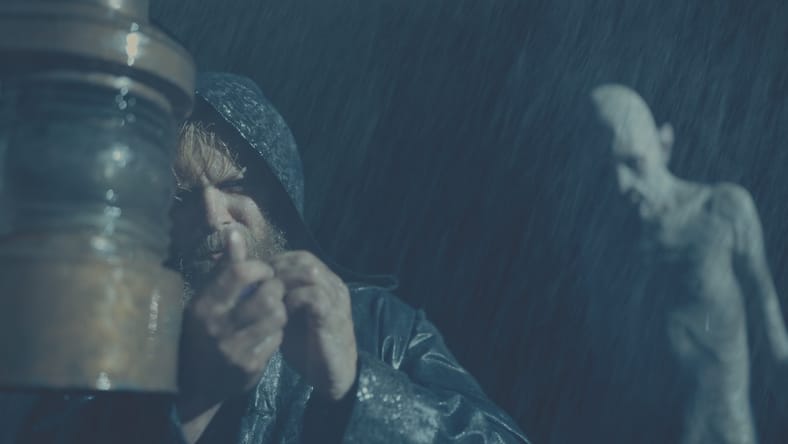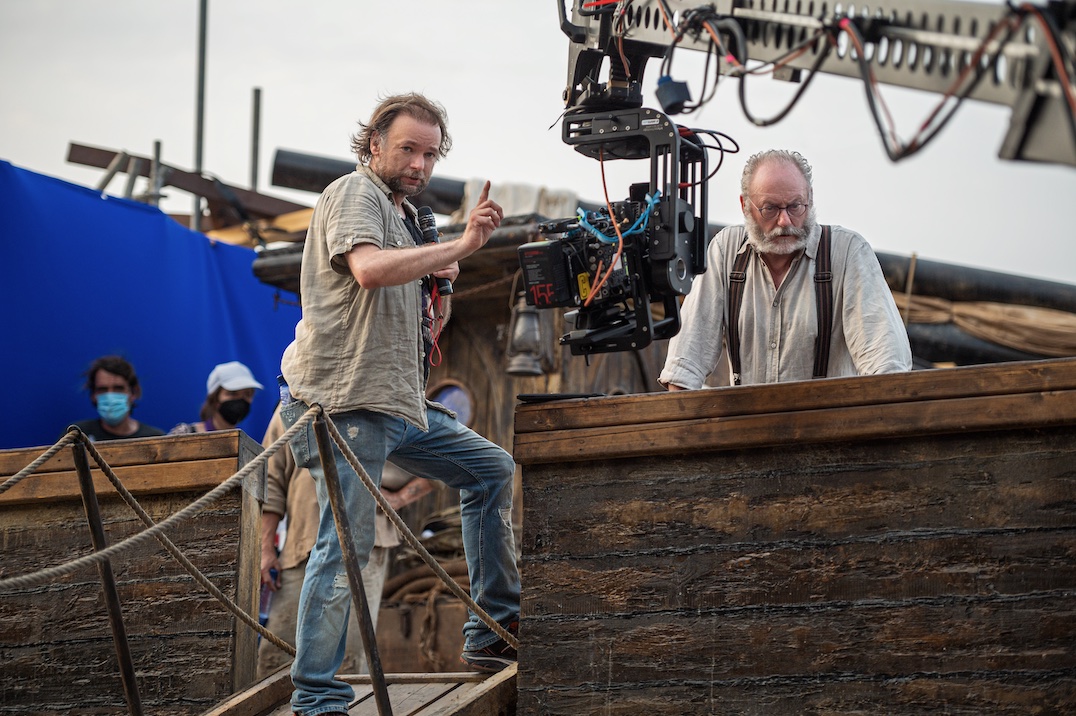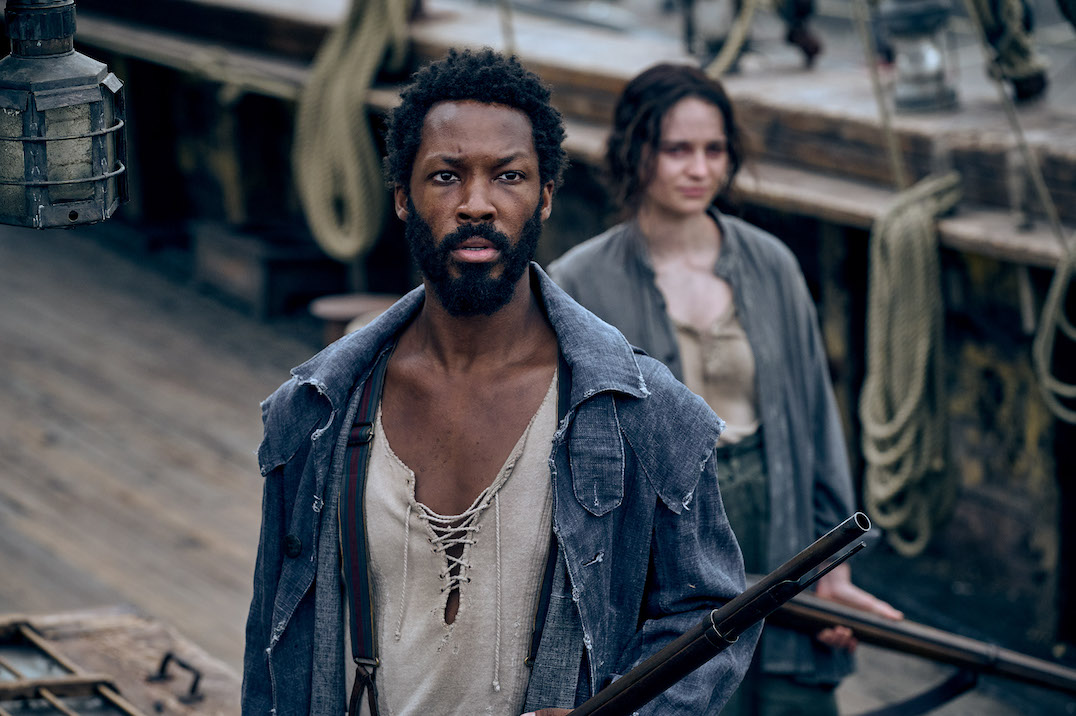
It’s hard to find a new take on Dracula, who had been portrayed on film 538 times as of 2015, when he won a Guinness World Record for the most-portrayed literary character in film. But André Øvredal’s The Last Voyage of the Demeter manages to find a very fresh approach.
The Last Voyage of the Demeter focuses on the unfortunate souls aboard a schooner traveling from Carpathia to London who are unknowingly stuck with a bloodthirsty stowaway. They have no idea that a terrifying monster is hiding among them, and that he’s going to need some fresh blood before they get to shore.
The key to this fresh approach, ironically enough, was going back to the oldest vampire source material — Bram Stoker’s 1897 novel, Dracula.
Chapter 7, to be exact: The Captain’s Log.
The chapter centers around a newspaper clipping about a ship called the Demeter, and it also includes the captain’s logbook from a voyage in which several sailors went mysteriously missing. The captain writes about nervous talk amongst the crew about a “strange man” aboard the ship who is “tall and thin, and ghastly pale.”
“To die like a sailor in blue water, no man can object. But I am captain, and I must not leave my ship,” the captain writes in Chapter 7. “But I shall baffle this fiend or monster, for I shall tie my hands to the wheel when my strength begins to fail, and along with them I shall tie that which He, It, dare not touch. And then, come good wind or foul, I shall save my soul, and my honour as a captain.”
“Taking this one chapter from the book and then making a whole movie out of it is such a brilliant idea,” says Øvredal, who considers Dracula our most enduring villain.
“It just felt like such an original and wonderful point of view on Dracula, because it’s always the Gothic drama with horror, but a drama about his journey — it’s usually the whole book, or a version of it.”

The Origins of Last Voyage of the Demeter
The Demeter script was first written by Bragi F. Schut in 2002, with subsequent additions by Stefan Ruzowitzky (The Counterfeiters) and Zak Olkewicz (Bullet Train).
The cast includes Corey Hawkins (In the Heights, Straight Outta Compton) as Clemens, a doctor who joins the crew of the Demeter; Aisling Franciosi (Game of Thrones, God’s Creatures) as an unintentional stowaway; Liam Cunningham (Game of Thrones, Clash of the Titans) as the captain of the Demeter; and David Dastmalchian (Dune, Ant-Man) as the first mate.
When Øvredal first read the script, he knew he had to be a part of it. After more than 20 years of attempts by different directors — from Neil Marshall to David Slade — Øvredal was the one who finally made it stick. He had the support of Steven Spielberg’s Amblin Pictures and producer Brad Fischer, with whom Øvredal also worked on a not-yet-released adaptation of Stephen King’s The Long Walk. The film is also produced by Arnold Messer and Mike Medavoy (Black Swan, Shutter Island) for Phoenix Pictures, and is executive produced by Matthew Hirsch (Charlie’s Angels, Rough Night).
“Immediately as you start reading the script, you can just feel this awesome retelling,” Øvredal says of Demeter. “I just really happened to be the one who was there when it finally came together.”
A story about sailors disappearing from a ship without a trace, at the mercy of an unknown monster, fits perfectly into the horror movie genre — and Øvredal knows it well. The Norwegian director is behind the 2019 movie adaptation of the popular children’s book series Scary Stories to Tell in the Dark produced by Guillermo Del Toro, the sequel of which is coming soon.
Øvredal is also behind 2010’s Trollhunter, about a group of documentary filmmakers who follow a scientist as he hunts a giant troll, and 2016’s The Autopsy of Jane Doe, featuring Succession star Brian Cox and Into the Wild’s Emile Hirsch.
Like Chapter 7 of Dracula, The Last Voyage of the Demeter “gets scarier and scarier” as more and more sailors begin to disappear, Øvredal says. “Now we’re all in absolute terror. We’re carrying this thing that’s on board with us.”
Captain’s Log

Corey Hawkins as Clemens and Aisling Fraciosi as Anna crouch down on the deck of the Demeter. Rainer Bajo/Universal Pictures and Amblin Entertainment. © 2023 Universal Studios and Amblin Entertainment.
Other Dracula movies have used bits and pieces from Chapter 7 before. John Badham’s 1979 Dracula, starring Frank Langella, opens with a boat scene, and Francis Ford Coppola’s 1992 Bram Stoker’s Dracula, with Gary Oldman as the bloodthirsty count,includes a Demeter sequence. But to the best of Øvredal’s knowledge, The Last Voyage of the Demeter is the first movie to focus solely on the seafaring chapter of the story.
“That seemed to be fresh from the get-go,” Øvredal says. “I just have to make it grounded. I have to be with the crew and watch this demon attack them and see what happens to them, and make the audience care about these characters who are now in peril throughout this journey that they can’t escape, out in the Mediterranean Sea.”
Also Read: Gary Oldman Doesn’t Think Citizen Kane Is the Best Movie Ever — Or Even the Best Orson Welles Movie
Shooting a movie that takes place on a boat roughly 90 percent of the time came with plenty of challenges. So Øvredal filmed it in two parts — first the interiors and then the exteriors.
“We split the ship basically in two,” he says. “The interior we shot up in Babelsberg in Berlin. We built the whole interior of the ship on stage. It’s a huge ship with real wood. Everything is amazing construction. Then we went to Malta to the tanks that they have there, which is sitting right on the ocean, and you can see out on the Mediterranean Sea. We were able to use that as part of our background.”
With the ship on a gimbal surrounded by rain and water towers to simulate a storm, the director had his work cut out for him. But the most challenging part was making sure the complicated rig was safe for the cast and crew to work on in the dark during night shoots.
“The movie had to take place at night because Dracula doesn’t like light. So we shoot with a view to the Mediterranean Sea and there is wind coming in, there’s weather — and we have to make sure everything is super safe for everyone,” he says. “In theory, the ship is just a rigid thing that’s just lying there. It’s not flowing with the wind and water like a real ship would. It’s just our set. So we have to make sure that the wind doesn’t topple the whole thing over. There’s so much safety stuff around all that.”
To top it all off, it was blisteringly hot in Malta during the summer of 2021, and Covid protocols required that everyone in the crew wear masks. But if the film set was slightly stressful due to safety requirements and weather conditions, well, that’s nothing compared to the stress of being stalked by a vampire.
The film’s trailer presents a Dracula who is more monster than man. But Øvredal assures us that he’s quite sophisticated. Or at least sophisticated enough to know who he’s killing and why — even if he doesn’t care.
“I doubt he feels bad. I guess he’s quite used to what he’s doing. I mean, he’s 400 years old or something, isn’t he? He’s done this for a living for this entire time,” Øvredal laughs. “I don’t think he has much remorse at this point. But he’s definitely a person with a consciousness, and I think that should come through. The story is about the crew chasing this unknown devil on their ship. But we also see it from their point of view, because they don’t understand what they’re facing.”
To that end, Øvredal believes the key to making a convincing horror movie is to engage with the characters.
“I really think that the environment around the characters is so important in creating a space where horror can take place, and I think you need to leave so much open for the audience to interpret and to feed into their imagination,” he says. “Building upon Hitchcock’s basic ideas of how to create suspense, because I think horror is just suspense with a supernatural twist, in a way.
“So whether it’s a Hitchcockian spy-thriller, or it’s a horrific scary movie, I think some of the building blocks of how to engage your audience on that visceral level are still the same.”
The Last Voyage of the Demeter arrives in theaters Friday, from Universal Pictures.
Main image: Larsen (Martin Furulund) and Nosferatu (Javier Botet) in The Last Voyage of the Demeter, directed by André Øvredal. Courtesy of Universal Pictures.
Share:

